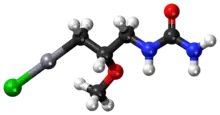Chlormerodrin
 | |
| Names | |
|---|---|
| IUPAC name
3-carbamoylamino-2-methoxypropylmercury(II) chloride | |
| Systematic IUPAC name
3-chloro-mercura-2-methoxy propylurea | |
Other names
| |
| Identifiers | |
CAS Number |
|
3D model (JSmol) |
|
| ECHA InfoCard | 100.000.483 |
PubChem CID |
|
SMILES
| |
| Properties | |
Chemical formula |
C5H11ClHgN2O2 |
| Molar mass | 367.20 g·mol−1 |
| Appearance | Solid |
| Melting point | 152.5 °C (306.5 °F; 425.6 K) |
Solubility in water |
11 g/l |
| Hazards | |
| Occupational safety and health (OHS/OSH): | |
Main hazards |
Renal mercury poisoning |
Except where otherwise noted, data are given for materials in their standard state (at 25 °C [77 °F], 100 kPa). | |
| Infobox references | |
 | |
 | |
| Clinical data | |
|---|---|
| AHFS/Drugs.com | Medical Encyclopedia |
| ATC code |
|
| Legal status | |
| Legal status |
|
| Identifiers | |
IUPAC name
| |
| CAS Number | |
| PubChem CID | |
| DrugBank | |
| ChemSpider | |
| UNII | |
| ChEBI | |
| ChEMBL | |
| ECHA InfoCard | 100.000.483 |
| Chemical and physical data | |
| Formula | C5H11ClHgN2O2 |
| Molar mass | 367.196 g·mol−1 |
| 3D model (JSmol) | |
SMILES
| |
InChI
| |
Chlormerodrin is a mercurial diuretic commercially traded from 1952[1] until 1974[2] that was once used to treat patients with heart failure,[3] but is no longer in widespread use.[4] The radiolabelled form (197Hg & 203Hg) had also been used for medical imaging of the kidney and brain[5][6] and the 197Hg form was even considered a contender for 99mTc by some physicians,[7] but was ultimately discontinued by the FDA in 1989.[8]
References
- ↑ M. Sittig, Pharmaceutical Manufacturing Encyclopedia, Noyes Publications, Westwood, 1988.
- ↑ J. R. Crout, Fed. Regist. 1974, 39, 42018–42019.
- ↑ Leff WA, Nussbaum HE (April 1959). "Chlormerodrin: clinical effectiveness and absence of toxicity in congestive heart failure; report of a four-year study". British Medical Journal. 1 (5126): 883–9. doi:10.1136/bmj.1.5126.883. PMC 1992943. PMID 13629153.
- ↑ PubChem. "Chlormerodrin". pubchem.ncbi.nlm.nih.gov. Retrieved 2021-09-23.
- ↑ D. B. Sodee, B. Di Stefano, Ohio State Med. J. 1965, 61, 819–822.
- ↑ Yamamoto, Y. L.; Feindel, W.; Zanelli, J. (1964-09-01). "Comparative study of radioactive chlormerodrin (Neohydrin) tagged with mercury 197 and mercury 203 for brain scanning". Neurology. 14 (9): 815–815. doi:10.1212/wnl.14.9.815. ISSN 0028-3878.
- ↑ D. B. Sodee, J. Nucl. Med. 1968, 9, 645.
- ↑ FDA, Approved Drug Products with Therapeutic Equivalence Evaluations, US Department Of Health And Human Service, 1989.
This article is issued from Offline. The text is licensed under Creative Commons - Attribution - Sharealike. Additional terms may apply for the media files.